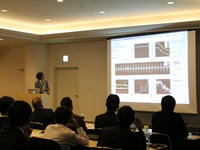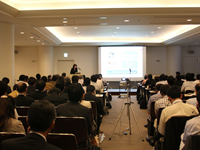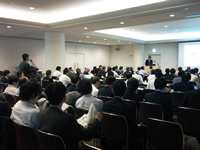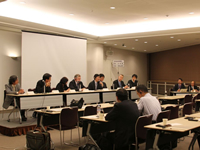ERATO http://www.jst.go.jp/erato/
On October 25, 2013, the International Symposium on Wearable Health Care Sensors was held at Pacifico Yokohama. Co-hosted by the University of Hyogo and the Micro System Integration Center at Tohoku University, the Symposium was chaired by Professor Kazusuke Maenaka (Graduate School of Engineering, University of Hyogo), who is Research Director of ERATO Maenaka Human-Sensing Fusion project.
This symposium was held both to provide a forum for exchanging information and to hear presentations from experts in diverse fields of business and technology on the current situation and future prospects of wearable health care sensors, which are expected to develop into a significant market in the near future. Researchers and entrepreneurs from Europe, North America, and Asia were invited to speak as presenters. Reflecting the high level of interest in this field, the venue was packed throughout with 150 participants, principally from industry, and the symposium concluded on a very successful note.
In the keynote speech, President Kohei Ohno of HST Inc. delivered a presentation on his experiences in the development of medical equipment over many years, as well as related considerations such as the commercialization of health care.
Next, Professor Maenaka explained the results and future issues of the small patch-type health care monitoring sensor that has been researched and developed under his ERATO project.
This was followed by presentations from Virginia Natale of ST Microelectronics, Inc. (Switzerland), Professor Jukka Lekkala of Tampere University (Finland), Valer Pop of imec/Holst Centre (Netherlands), Professor Yong Lian of York University (Canada)/National University of Singapore, Dr. Hironori Sato of Omron Healthcare, Co., Ltd., Andy Westby of Preventice Inc., (USA), and Associate Professor Takuya Maekawa of Osaka University, who spoke on the latest technological developments and the state of business development in each country.
At the end of the symposium, a panel discussion was held in which all presenters took the stage. Questions were fielded from the floor and a lively discussion was held, centering on four themes of great interest: the technical challenges facing wearable health care sensors; the presence or absence of discomfort caused by long-time use; potential catalysts for the spread of wearable health care sensors; and the legal and regulatory situation in each country regarding the collection of biological information from sensors. Given the spread of health care sensors amid the ongoing aging of society worldwide, it was argued that national governments should establish some kind of system for the use of these devices; however, it was also pointed out that we must make our own efforts to stimulate needs, rather than relying on public assistance. In addition, it was argued that the market does not necessarily demand state-of-the-art technology with respect to hardware; rather, ease of use is a top priority for device users. If we can demonstrate ease of use and work to create user needs, the initial cost will fall, facilitating the spread of this technology in future.
At this symposium, the audience benefited from an introduction to the research results of the ERATO Maenaka Human-Sensing Fusion project, as well as information on business development for wearable health care monitors which have progressed thanks to research and development under the project. In addition, participants from companies both in Japan and abroad benefited from the many useful suggestions provided during the presentations and discussions by leading researchers and entrepreneurs in each country.




JST, an integrated organization of science and technology in Japan, establishes an infrastructure for the entire process from the creation of knowledge to the return to the society. For more information, visit http://www.jst.go.jp/EN/